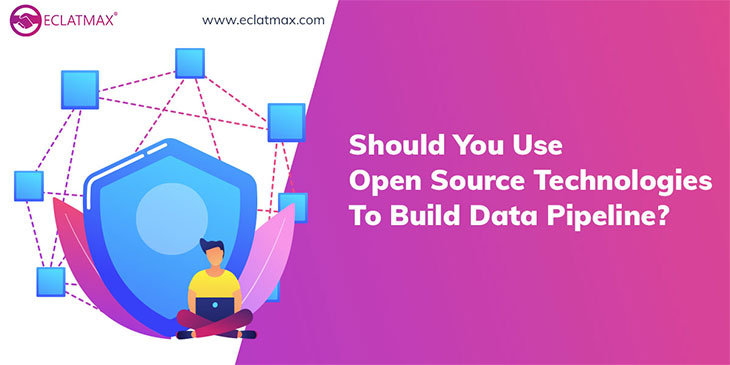Open-source technological
In simple phrases open-source software program is software whose supply code is posted and made accessible to the public, enabling all and sundry to copy, adjust, and redistribute the source code without paying royalties or fees. Open-source code can evolve thru neighborhood cooperation. These communities are composed of man or woman programmers as nicely as large companies.
Linux, Apache, MYSQL, and PHP are some of the open-source software program offerings Benefits use for the development and web hosting of our popular BWEB Content Management Software.
Open-source projects are regularly loosely prepared with “little formalized technique modeling or support”, however, utilities such as difficulty trackers are frequently used to organize open-source software development.

Data pipeline
A Data pipeline is a sequence of documents processing steps. If the statistics are no longer currently loaded into the statistics platform, then it is ingested at the taking off of the pipeline. Then there is a sequence of steps in which every step offers you an output that is the input to the subsequent step. This continues until the pipeline is complete. In some cases, independent steps might additionally be run in parallel.
Data pipelines consist of three key basics: a source, a processing step or steps, and a destination. In some facts pipelines, the destination may also be known as a sink.
Parts of a data pipeline
Data ingestion
Filtering and Enrichment
Routing
Processing
Querying / Visualization / Reporting
Data warehousing
Reprocessing capability
Building Data Pipelines
Data pipelines elevate and technique data from facts sources to the commercial enterprise talent (BI) and ML purposes that take benefit of it.
These pipelines consist of a couple of steps: analyzing data, shifting it from one system to the next, reformatting it, joining it with other records sources, and including derived columns (feature engineering).
When the persistence of giant facts units is important, Hive presents diverse computational methods and is value-effective. Alternatively, Spark gives an in-memory computational engine and maybe a higher desire if processing velocity is critical. Spark also presents the excellent services for close to real-time statistics streaming, allowing engineers to create streaming jobs the equal way they write batch jobs. However, micro-batching with Hive may additionally be a viable and more affordable option.
How open-source can help you to take control of your data pipeline?
Free and open-source software (FOSS)
Free and open-source tools (FOSS for short) are on the rise. Companies opt for the FOSS software program for their data pipelines due to the fact of its transparent and open codebase, as nicely as the reality that there are no charges for using the tools. Among the most super FOSS solutions are:
Petal, Bonobo, or the Python standard library – software program that helps you to extract records from its sources.
Pandas – with its Excel-like tabular approach, pandas is one of the high-quality and easiest solutions for manipulating and remodeling your data, simply like you would in a spreadsheet.
Apache Airflows: Apache Airflows allows you to schedule, orchestrate, and display the execution of your complete statistics pipeline.
Postgres – one of the most famous SQL databases. Postgres adds to the traditional characteristic set of SQL databases by extending its records type help (covers unstructured data with JSON fields) and imparting built-in functions that velocity up analytics.
Metabase: a lightweight utility layer on top of your SQL database, which speeds up querying and automates the documented era for the non-technical user.
PROS:
Free – There are no seller costs.
Fully customizable – Open source capability that you can look into the code and see what it does on a granular level, then tailor it to swimsuit your specific use case.
No dealer lock-in – No contractual responsibility to maintain with a supplier who doesn’t fulfill your needs.
Community support – FOSS has a lot of fans who offer a lot of support on Stack Overflow and other channels.
Fun – FOSS solutions allow for a lot of tinkering, which – we’re equipped to admit it – is fun.
Data warehousing
Reprocessing capability
CONS:
Solution lock-in – Customized solutions are difficult to disentangle when transferring to a specific device or platform, in particular when home-brewed options do no longer observe the quality engineering practices.
High upkeep costs – Every alternate to the facts pipeline requires you to invest engineering hours… and data pipelines trade a lot. From APIs altering their endpoints to software program enhancements deprecating libraries, FOSS solutions are guilty of excessive preservation costs.
Lack of technical support – When things go wrong, there’s no one to name who can help you get to the bottom of your technical mess. You have to be extra self-reliant and finances for errors.
Scaling. – As your company grows, so do your needs. The engineering options vary appreciably depending on the scale of your information operations. For example, imposing the infrastructure for a dispensed message broking makes feel when you are processing excessive volumes of streaming data, however now not when you are gathering advertising spend by way of APIs. FOSS solutions require you to improve in-house information in scaling infrastructure (costly) or outsource it to contractors alternatively (also costly).
Time-to-insights probability costs – The average time it takes to build your complete facts pipeline is north of 9 months. Vendor solutions shorten the timeline from months to weeks, so you skip the probability expenses accrued when waiting for your BI infrastructure to be prepared to reply questions.
Who is it for?
Data-scarce corporations who do now not diagram to scale.
Small records pipelines, which are developed as prototypes within a larger ecosystem.
Hobbyists and tinkerers.
Others tool for build data pipeline:
Keboola
Keboola is Software as a Service (SaaS) records operations platform, which covers the complete records pipeline operational cycle. From ETL jobs (extract-transform-load) to orchestration and monitoring, Keboola presents a holistic platform for records management. The structure is designed modularly as plug-and-play, allowing for higher customization.
Stitch
Stitch is an ETL platform that helps you to join your sources (incoming data) to your destinations (databases, storage, and statistics warehouses). It is designed to decorate your modern-day system by way of smoothing out the edges of ETL strategies on information pipelines.
Segment
The records pipeline is at the coronary heart of your company’s operations. It lets you take manipulate of your records and use it to generate revenue-driving insights.
Though, control all the records pipeline operations (data extractions, transformations, loading into databases, orchestration, monitoring, and more) can be a petite scary.
Fivetran
Fivetran enables you to join your records sources to your locations thru data mappings. It supports a massive listing of incoming data sources, as nicely as statistics warehouses (but no longer data lakes).
Xplenty
Xplenty is a facts integration platform that connects your sources to your destinations. Through its graphical interfaces, users can drag-and-drop-and-click records pipelines together with ease.
Etleap
With its clickable user interface, Etleap allows analysts to create their personal data pipelines from the alleviation of the person interface (UI). Though on occasion clunky, the UI offers a large variety of customization except for the want to code.
What's the difference between open-source software programs and different types of software?
Some software has source code that solely the person, team, or organization who created it—and continues different control over it—can modify. People name this type of software program “proprietary” or “closed source” software.
Only the unique authors of proprietary software can legally copy, inspect, and alter that software. And to use proprietary software, pc customers should agree that they will not do whatever with the software that the software’s authors have no longer expressly permitted.
The open-supply software program is different. Its authors make its source code available to others who would like to view that code, reproduction it, study from it, alter it, or share it.
Four reasons to use Open Source Software:
Open source continues expenses down:
Cost savings may additionally be only part of open source’s allure, but it is still a large part, no count number what sizes the organization. How can Netflix charge as tiny as $8 (USD) for a month for its service? Because it is constructed by open-source software. They cantered on content, now not building an operating machine or a testing framework.
Open source improves quality:
Open supply fans have long contended that the methodology produces higher software. Their reasoning: If code is flawed, the developer neighborhood can pick out and tackle the trouble quickly, where a single coder would possibly plod on unawares, at least for a while.
Open source can provide enterprise agility:
Not to be confused with agile development, commercial enterprise agility is the ability to react to market demands quickly. Open supply offers this to builders and agencies alike via speeding up the pace of software program development.
Open source mitigates commercial enterprise risk:
Another, possibly unsung, advantage to using open-source tools, and thereby reducing dependence on a single or multiple vendors, is that the open-source option might also limit business risk. If a developer stops working on your software due to unexpected circumstances then there is a considerable pool of builders you can name on to continue the project.
Open-source use for building pipelines:
Data pipeline structure is the layout and structure of code and structures that copy, cleanse or radically change as needed, and route source facts to vacation spot systems such as facts warehouses and facts lakes
Open Source product development pace trumps that of any personal undertaking A lot of records management innovation happens in Open Source is speedy to soak up innovation from any source The pragmatic evolutionary improvement cycles are efficient in enhancing the quality
Using Open Source guarantees continued access to enterprise imperative data
Avoid lock-in to a single vendor
Even with the 10 – 20-year lifespan
Databases in the Pipeline
Specialized Open Source database technologies accessible for exclusive use cases
Consider the identical requirements as for the streaming platform:
Access patterns: transactional, relational
Scalability
Reliability
Adaptability / Platform aid / SDKs
Open source platforms to build a data pipeline:
Open supply potential the underlying science of the tool is publicly accessible and therefore need customization for each use case. Being open-source this type of information pipeline equipment is free of charge at a very nominal price. This additionally means you would want to have the required expertise to develop and lengthen its functionality as per need. Some of the known open-source facts pipeline tools are:
Apache Kafka
Apache Kafka is an open-source movement processing platform. Originally, it is developed with the aid of LinkedIn, open-sourced in 2011, now a top-level Apache project. Nowadays used with the aid of e.g. New York Times, Pinterest, Zalando, Airbnb, Shopify, Spotify, and many others for tournament streaming.
As a Python-oriented team, we’ve additionally committed to using Faust, an open-source Python library with comparable performance to Kafka streams. As our default flow processing framework, that offers AVRO codec and schema registry support.
Airflow
Airflow is an open-source platform formed with the aid of AirBnB to programmatically author, schedule, and display workflows. It is likely the most well-known records pipeline device out there. Using Airflow is comparable to the use of a Python package. It is nicely written, effortless to understand, and customizable. Your developers can create an information pipeline for you with unlimited complexity. You can work with any wide variety of records sources, connect to any statistics warehouse, and use any BI tool. Airflow is completely free to use and completely customizable. But if you are a small team, you can also favor a more straightforward, less code-heavy device to get your facts to pipeline up and walking swiftly.
DBT
DBT permits anybody comfortable with SQL to own the complete facts pipeline from writing data transformation code to deployment and documentation.
DBT is free, open-source, and has a giant and lively online community. Moreover, it is used by way of lots of corporations such as GitLab, Canva, and Simply Business
Every statistics model in DBT is an easy SELECT statement, and DBT handles turning those into tables and views in a statistics warehouse. At the core is the ref function, which lets you reference one model within any other and routinely construct dependency graphs. Thus, when you update your data, DBT routinely updates all your materialized tables in the format in the right order.
Data form
Like DBT, Data-form has a free, open-source software program package, SQLX that lets you build records transformation pipelines from the command line. Plus, they offer a paid internet service, Data-form Web, to seamlessly control pipelines, documentation, testing, and sharing records fashions with your team
Data-form is very comparable to DBT however a smaller neighborhood and fewer corporations have the usage of it. Using their open-source software program is free, and their browser-based IDE is free for a fact crew of one. If you use Data-form Web, they manipulate your infrastructure for you. In this respect, it is easier than debt (where you need to manipulate your infrastructure).
Lastly, there are agency applications reachable that encompass SSO, provide cloud deployment, and a committed account manager. If you select the paid option, Data-form is barely more cost-effective and more straightforward than DBT and is a strong desire to scale your business’s data pipelines.
Some Benefits of use Open Source Technologies:
Flexibility:
The largest benefit of open source is that it presents first-rate flexibility to use the platform following your needs. Interoperability and connectivity with the current infrastructure or the platform are easier to achieve and it also presents the liberty to the customers to make modifications to its features.
Reliability:
Open supply is continually under continuous review, which leads to extra reliability of the platform. Programs like Apache, DNS, HTML, and Perl have established to be strong and dependable even beneath strict conditions. Since developers devote their time and expertise, it is updated regularly and more than a few facets get delivered to it from time to time.
Quality:
A software platform that is developed by way of limitless users generally improves the best of the product as many new and modern features get brought and the product receives enhanced. In general, the technology receives closer to the customers as they can have a free hand in making it also. And this is the prime reason for agencies to choose the software.
Support options:
Open source is normally on hand for free and it has a huge community crew to guide the piece of software. The neighborhood works together and creates a variety of modules that can be used via paid support options. The fee nevertheless lies some distance beneath the one the proprietary vendors usually charge. For any troubles confronted with the software, the community is continually there to help you out, which saves a lot of time.
Conclusion:
Open source is the high-quality bet to meet the information management challenges
Kafka as the central aspect of a data pipeline helps clean up messy architectures
host of appropriate Open Source database options can help to meet the information storage and get admission to needs
You can leverage a host of managed service carriers or build your very own capability
With Open Source, you have the option to revisit that choice at any time













